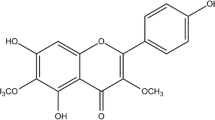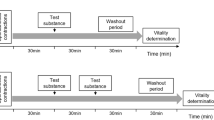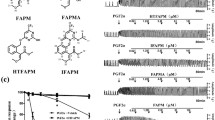Abstract
We previously reported that shakuyaku-kanzo-to, a kampo medicine consisting of shakuyaku and kanzo, has an inhibitory effect on myometrial contractions in pregnant women. In this study, we evaluated the effects of kanzo, glycyrrhizin (a major component of kanzo), glycyrrhetinic acid (GA; a major metabolite of glycyrrhizin), shakuyaku, and paeoniflorin (a major component of shakuyaku) on agonist-induced contractions of the uterus of pregnant humans and rats. We prepared myometrial strips from the uterus of pregnant humans and rats and induced contractions with oxytocin (50 μU/mL) or prostaglandin F2α (PGF2α) (10−7 or 10−6 M). Kanzo (250 μg/mL) and GA (5 × 10−6 M) inhibited the oxytocin-induced and PGF2α-induced contractions in pregnant human and rat myometrium, but shakuyaku (250 μg/mL), paeoniflorin (10−5 M), and glycyrrhizin (10−5 M) did not inhibit contractions in either. Interestingly, kanzo and GA showed an inhibitory effect after temporarily enhancing the PGF2α-induced contractions in the rat myometrium, but not in the human myometrium. These results suggest that kanzo has at least a two-step inhibitory effect on the myometrial contractions that originate from the kanzo itself and a metabolite of glycyrrhizin in kanzo. Furthermore, kanzo was found to be safe for inhibiting PGF2α-induced contractions in humans because it did not temporarily enhance PGF2α-induced contractions.







Similar content being viewed by others
References
Hinoshita F, Ogura Y, Suzuki Y, Hara S, Yamada A, Tanaka N, Yamashita A, Marumo F (2003) Effect of orally administered shao-yao-gan-cao-tang (Shakuyaku-kanzo-to) on muscle cramps in maintenance hemodialysis patients: a preliminary study. Am J Chin Med 31:445–453
Hyodo T, Taira T, Kumakura M, Yamamoto S, Yoshida K, Uchida T, Sakai T, Endo T, Baba S, Hidai H (2002) The immediate effect of shakuyaku-kanzo-to, traditional Japanese herbal medicine, for muscular cramps during maintenance hemodialysis. Nephron 90:240
Hyodo T, Taira T, Takemura T, Yamamoto S, Tsuchida M, Yoshida K, Uchida T, Sakai T, Hidai H, Baba S (2006) Immediate effect of Shakuyaku-kanzo-to on muscle cramp in hemodialysis patients. Nephron Clin Pract 104:c28–c32
Tanaka T (2003) A novel anti-dysmenorrhea therapy with cyclic administration of two Japanese herbal medicines. Clin Exp Obstet Gynecol 30:95–98
Katsura T (1995) The remarkable effect of kanzo-to and shakuyakukanzo-to in the treatment of acute abdominal pain. Jpn J Orient Med 4:293–299
Inoue M, Yokoyama M, Ishii A, Watanabe T, Yamato T, Kumon H (2011) The effect of shakuyakukanzoto for renal colic. Jpn J Orient Med 62:359–362
Sakai Y, Tsuyuguchi T, Ishihara T, Kato K, Tsuboi M, Ooka Y, Katsuura K, Ohara T, Takayama S, Kimura M, Kasanuki J, Ai M, Yokosuka O (2009) Confirmation of the antispasmodic effect of shakuyaku-kanzo-to (TJ-68), a Chinese herbal medicine, on the duodenal wall by direct spraying during endoscopic retrograde cholangiopancreatography. J Nat Med 63:200–203
Ai M, Yamaguchi T, Odaka T, Mitsuhashi K, Shishido T, Yan J, Seza A, Saisho H (2006) Objective assessment of the antispasmodic effect of shakuyaku-kanzo-to (TJ-68), a Chinese herbal medicine, on the colonic wall by direct spraying during colonoscopy. World J Gastroenterol 12:760–764
Hosokawa A, Ogawa K, Ando T, Suzuki N, Ueda A, Kajiura S, Kobayashi Y, Tsukioka Y, Horikawa N, Yabushita K, Fukuoka J, Sugiyama T (2012) Preventive effect of traditional Japanese medicine on neurotoxicity of FOLFOX for metastatic colorectal cancer: a multicenter retrospective study. Anticancer Res 32:2545–2550
Yoshida T, Sawa T, Ishiguro T, Horiba A, Minatoguchi S, Fujiwara H (2009) The efficacy of prophylactic shakuyaku-kanzo-to for myalgia and arthralgia following carboplatin and paclitaxel combination chemotherapy for non-small cell lung cancer. Support Care Cancer 17:315–320
Tsuji S, Yasuda K, Sumi G, Cho H, Tsuzuki T, Okada H, Kanzaki H (2012) Shakuyaku-kanzo-to inhibits smooth muscle contractions of human pregnant uterine tissue in vitro. J Obstet Gynaecol Res 38:1004–1010
Sato Y, He JX, Nagai H, Tani T, Akao T (2007) Isoliquiritigenin, one of the antispasmodic principles of glycyrrhiza ularensis roots, acts in the lower part of intestine. Biol Pharm Bull 30:145–149
Kim BK, Ozaki H, Hori M, Karaki H (1996) Increased inhibitory effect of phorbol ester on cytosolic Ca2+ level and contraction in rat myometrium after gestation. Jpn J Pharmacol 72:111–118
Morrison JJ, Dearn SR, Smith SK, Ahmed A (1996) Activation of protein kinase C is required for oxytocin-induced contractility in human pregnant myometrium. Hum Reprod 11:2285–2290
Nakamoto T, Yasuda K, Yasuhara M, Nakajima T, Mizokami T, Okada H, Kanzaki H (2006) Cigarette smoke extract enhances oxytocin-induced rhythmic contractions of rat and human preterm myometrium. Reproduction 132:343–353
Hoshimoto K (2007) Combined with shakuyakukanzoto at the time of embryo transfer in is vitro fertilization. Jpn J Orient Med 58:475–479
Imai A, Horibe S, Fuseya S, Iida K, Takagi H, Tamaya T (1995) Possible evidence that the herbal medicine shakuyaku-kanzo-to decreases prostaglandin levels through suppressing arachidonate turnover in endometrium. J Med 26:163–174
Shibata T, Morimoto T, Suzuki A, Saito H, Yanaihara T (1996) The effect of shakuyaku-kanzo-to on prostaglandin production in human uterine myometrium (Article in Japanese). Nihon Sanka Fujinka Gakkai Zasshi 48:321–327
Kimura M, Kimura I, Nojima H (1985) Depolarizing neuromuscular blocking action induced by electro pharmacological coupling in the combined effect of paeoniflorin and glycyrrhizin. Jpn J Pharmacol 37:395–399
Yang Y, Shi Q, Liu Z, Li RJ, Pan PW, Hou YY, Lu WG, Bai G (2010) The synergistic anti-asthmatic effects of glycyrrhizin and salbutamol. Acta Pharmacol Sin 31:443–449
Wang CY, Kao TC, Lo WH, Yen GC (2011) Glycyrrhizic acid and 18β-glycyrrhetinic acid modulate lipopolysaccharide-induced inflammatory response by suppression of NF-κB through PI3K p110δ and p110γ inhibitions. J Agric Food Chem 59:7726–7733
Guan X, Wilson S, Schlender KK, Ruch RJ (1996) Gap-junction disassembly and connexin 43 dephosphorylation induced by 18 beta-glycyrrhetinic acid. Mol Carcinog 16:157–164
Davidson JS, Baumarten IM, Harley EH (1986) Reversible inhibition of intercellular junctional communication by glycyrrhetinic acid. Biochem Biophys Res Commun 134:29–36
Doring B, Shynlova O, Tsui P, Eckardt D, Jansen-Bienhold U, Hofmann F, Feil S, Feil R, Lye SJ, Willecke K (2006) Ablation of connexin 43 in uterine smooth muscle cells of the mouse causes delayed parturition. J Cell Sci 119:1715–1722
Kim DH, Lew SW, Han MJ (1999) Biotransformation of glycyrrhizin to 18beta-glycyrrhetinic acid-3-O-beta-d-glucuronide by Streptococcus LJ-22, a human intestinal bacterium. Biol Pharm Bull 22:320–322
Bando M, Shibahara N, Shimada Y, Meselhy MR, Akao T, Itoh T, Terasawa K (2000) Pharmacokinetic study of paeoniflorin, paeonimetabolin-1 and glycyrrhetic acid in humans after oral administration of paeony root, glycyrrhiza and shakuyaku-kanzo-to (sha-yao-gan-cao-tang). J Trad Med 17:26–33
Seitchik J, Amico JA, Castillo M (1985) Oxytocin augmentation of dysfunctional labor. Am J Obstet Gynecol 151:757–761
Kinoshita K, Satoh K, Sakamoto S (1977) Prostaglandin PGF2α and E1 in plasma and amniotic fluid during human pregnancy and labor. Endocrinol Jpn 24:155–156
Myatt L, Lye SJ (2004) Expression, localization and function of prostaglandin receptors in myometrium. Prostaglandins Leukot Essent Fatty Acids 70:137–148
Farina M, Ribeiro ML, Weissmann C, Estevez A, Billi S, Vercelli C, Franchi A (2004) Biosynthesis and catabolism of prostaglandin F2alpha (PGF2α) are controlled by progesterone in the rat uterus during pregnancy. J Steroid Biochem Mol Biol 91:211–218
Rask-Madsen J, Bukhave K, Madsen PE, Bekker C (1983) Effect of carbenoxolone on gastric prostaglandin E2 levels in patients with peptic ulcer disease following vagal and pentagastrin stimulation. Eur J Clin Invest 13:351–356
Minuz P, Cavallini G, Angelini GP, Lechi A, Brocco G, Riela A, Scuro LA, Velo GP (1984) Carbenoxolone and prostaglandin E2 and F2α gastric juice levels in man. Pharmacol Res Commun 16:875–884
Acknowledgments
We thank Ms. Miyuki Imai for her excellent technical assistance and Ms. Ayu Yamamoto for her secretarial assistance. This work was supported by a grant from the Japan Smoking Research Foundation.
Conflict of interest
The authors declare that there is no conflict of interest regarding the publication of this article.
Author information
Authors and Affiliations
Corresponding author
Rights and permissions
About this article
Cite this article
Sumi, G., Yasuda, K., Kanamori, C. et al. Two-step inhibitory effect of kanzo on oxytocin-induced and prostaglandin F2α-induced uterine myometrial contractions. J Nat Med 68, 550–560 (2014). https://doi.org/10.1007/s11418-014-0835-y
Received:
Accepted:
Published:
Issue Date:
DOI: https://doi.org/10.1007/s11418-014-0835-y




